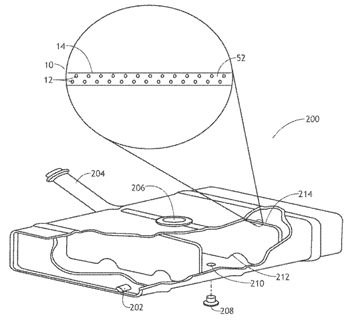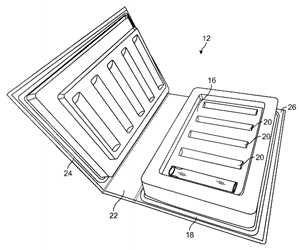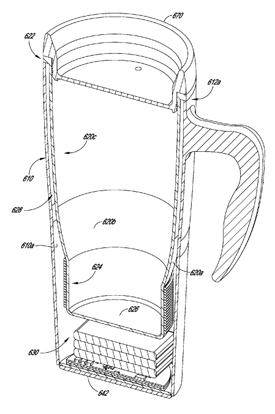 The Phase Change Matters e-mail newsletter is a weekly summary of the latest news and research on phase change materials and thermal energy storage. To subscribe, visit www.puretemp.com/subscribe. For more frequent updates, follow @puretemp on Twitter or visit the Phase Change Matters blog, www.puretemp.com/pcmatters.
The Phase Change Matters e-mail newsletter is a weekly summary of the latest news and research on phase change materials and thermal energy storage. To subscribe, visit www.puretemp.com/subscribe. For more frequent updates, follow @puretemp on Twitter or visit the Phase Change Matters blog, www.puretemp.com/pcmatters.
THERMAL ENERGY STORAGE
Innostorage TES conference set for Feb. 16-18 in Israel
Innostorage, an international research project aimed at developing efficient thermal energy storage systems using low-cost phase change materials, has issued a call for papers for its 2016 conference. The conference will be held Feb. 16-18 at Ben-Gurion University of the Negev in Israel.
Dr. Gennady Ziskind, head of the university’s Heat Transfer Laboratory, is organizing the conference. Prospective participants are asked to submit a four-page extended abstract by Oct. 1 for oral and poster presentations. No full papers will be required.
MARKET RESEARCH
20% annual growth projected for global PCM market through 2019
The global market for advanced phase change material is expected to reach $1.39 billion in 2019, according to the latest report from Technavio. That’s a compound annual growth rate of 20.03 percent from 2014 through 2019.
The report identifies increased environmental regulation and cost savings as important factors driving demand for PCMs, which are used in a variety of environmentally friendly heating and cooling applications. BASF, Cryopak, Phase Change Energy Solutions, Outlast Technologies, Honeywell Electronic Materials and Entropy Solutions are listed among the leading companies discussed in the report.
“Entropy Solutions is a key vendor in the market that offers 100% renewable phase-change materials that can be used for a broad range of temperature control applications,” said Faisal Ghaus, Technavio vice president. “New entrants that offer such innovative and green solutions are growing in the market, and this is expected to drive market growth during the forecast period.”
Global microencapsulation market projected to top $9 billion by 2021
The global market for microencapsulation is expected to surpass $9.08 billion by 2021, according the latest report on the sector by Decision Databases. That’s a compound annual growth rate of 9 percent from 2016 to 2021. The market was valued at $5.07 billion in 2014.
Microencapsulation is the process of surrounding a core of tiny particles or droplets with a coating such as ethyl cellulose, polyvinyl alcohol, melamine-formaldehyde or sodium alginate. Microencapsulation is used to contain, preserve or slowly release compounds used in a wide variety of applications in agriculture, cosmetics, pharmaceuticals and other industries. Leading microencapsulation companies include Nestle, Procter & Gamble, Encapsys and Microtek Laboratories.
“The food and beverages industry is seeing revolutionary product evolution by using this technology,” Decision Databases said in a press release. “Though the pharmaceutical industry is the strongest and largest industry for microencapsulation, other industries like household utilities and products, agrochemicals, [and phase change materials] among others are also responsible for driving this high CAGR.”
WEBINARS
“Deep Material Vetting,” offered through the U.S. Green Building Council, is aimed at designers struggling to find detailed toxicity data on building components. Instructors Chris Lee and Scott Kelly of Re:Vision Architecture share their “no-more-tears research strategies and time-saving workflows.” Continuing education units are available: 1 GBCI CE hour, 1 AIA LU/HSW, 1 LFA hour. $45.
“Differential scanning calorimetry,” offered by Mettler-Toledo International, explains the basic principles of DSC. For visual learners, it’s a good companion to Entropy Solutions’ “Understanding the differential scanning calorimetry of PCMs.” Free, but registration is required.
“Enhancing Phase Change Materials,” sponsored by C-Therm Technologies, takes a look thermal characterization tools. The presentation focuses on a South Korean study which found that adding exfoliated graphene nanoplatelets to phase change material can increase a PCM’s thermal conductivity. Free, but registration is required.
PATENT APPLICATIONS
Fluid system and method of making and using the same
U.S. patent application 20150240759 (applicant GM Global Technology Operations, Troy, Mich.):
 “A number of variations may include a product including a housing including at least one phase change material and a medium constructed and arranged for thermal energy transfer to or from a vehicle fuel. … [E]thanol fuel may be prone to clogging of the vehicle engine within the surroundings during undesirable conditions. This clogging may cause the vehicle engine to stall or not start upon desired ignition. … [W]hen the conditions become undesirable … the phase change material within the housing may at least partially freeze or solidify, releasing thermal energy through the medium and into the ethanol fuel. The increased thermal energy to the ethanol fuel may allow at least a portion of the ethanol fuel’s gel, wax-like, or crystalline state to liquefy or melt enough to start or continue to run the vehicle engine.”
“A number of variations may include a product including a housing including at least one phase change material and a medium constructed and arranged for thermal energy transfer to or from a vehicle fuel. … [E]thanol fuel may be prone to clogging of the vehicle engine within the surroundings during undesirable conditions. This clogging may cause the vehicle engine to stall or not start upon desired ignition. … [W]hen the conditions become undesirable … the phase change material within the housing may at least partially freeze or solidify, releasing thermal energy through the medium and into the ethanol fuel. The increased thermal energy to the ethanol fuel may allow at least a portion of the ethanol fuel’s gel, wax-like, or crystalline state to liquefy or melt enough to start or continue to run the vehicle engine.”
Self-modulating air register
U.S. patent application 20150245532 (assignee Acta Technology Inc., Boulder, Colo.):
“This invention is a novel air supply register that modulates the incoming air supply from the under floor air duct. This air register is able to monitor the air temperature leaving the server stack thereby improving the response time of the HVAC system. Since the register has adjustable louvers that can modulate the inlet air flow into the server stack; it will save energy by reducing the supply air to the server stack when the cool incoming air is not needed. This reduces hot spots in the data center because the cool incoming air can be directed to server racks that need cooling. This self-modulation of the air register is not available in conventional floor registers. … [Power units use] a phase change material to move the said louvers through said linkages so that the outlet air of the said air register can be modulated.”
Transport container assembly
 U.S. patent application 20150239640 (assignee Paradigm Design Solutions Inc., Los Angeles):
U.S. patent application 20150239640 (assignee Paradigm Design Solutions Inc., Los Angeles):
“A transport container assembly is provided for transporting temperature-sensitive material. The container includes a housing assembly that defines an interior cavity that provides a stable temperature environment therein. The housing includes a shell and a phase control material (PCM) within the shell. The shell defines an internal volume and the PCM is confined within the internal volume.”
Modular latent heat thermal energy storage system
U.S. patent application 20150241137 (applicant UChicago Argonne LLC):
“The invention provides a modular device for latent heat storage, which is made of a conduit with a first end and a second end; and a jacket that surrounds a portion of the conduit between the first end and the second end, wherein the jacket is comprised of at least one phase change material. The invention further provides a system for latent heat storage, comprising a thermally insulated enclosure adapted to receive at least one modular latent heat storage device and a HTF, wherein the HTF flows from an upstream heat source into each of the first ends of the conduit and out of each of the second ends of the conduit comprising the at least one module to a downstream heat exchanger.”
Heated or cooled dishware or drinkware
U.S. patent application 20150245723 (applicant Ember Technologies, Westlake Village, Calif.):
 “An actively heated mug, travel mug, baby bottle, water bottle or liquid container is provided. The mug, travel mug, baby bottle, water bottle or liquid container can include a body that receives a liquid therein and a heating or cooling system at least partially disposed in the body. The heating or cooling system can include one or more heating or cooling elements that heat a surface of the receiving portion of the body and one or more energy storage devices. The mug, travel mug, baby bottle, water bottle or liquid container can include a wireless power receiver that wirelessly receives power from a power source and control circuitry configured to charge one or more power storage elements and to control the delivery of electricity from the one or more power storage elements to the one or more heating or cooling elements. The mug, travel mug, baby bottle, water bottle or liquid container also can have one or more sensors that sense a parameter of the liquid or sense a parameter of the heating or cooling system and communicates the sensed information to the control circuitry. The control circuitry can turn on, turn off, and/or operate the heating or cooling element to actively heat or cool at least a portion of the body to maintain the liquid in a heated or cooled state generally at a user selected temperature setting based at least in part on the sensed parameter information. The mug, travel mug, baby bottle, water bottle or liquid container can also be paired with a remote device or mobile electronic device to send or receive communications or commands.”
“An actively heated mug, travel mug, baby bottle, water bottle or liquid container is provided. The mug, travel mug, baby bottle, water bottle or liquid container can include a body that receives a liquid therein and a heating or cooling system at least partially disposed in the body. The heating or cooling system can include one or more heating or cooling elements that heat a surface of the receiving portion of the body and one or more energy storage devices. The mug, travel mug, baby bottle, water bottle or liquid container can include a wireless power receiver that wirelessly receives power from a power source and control circuitry configured to charge one or more power storage elements and to control the delivery of electricity from the one or more power storage elements to the one or more heating or cooling elements. The mug, travel mug, baby bottle, water bottle or liquid container also can have one or more sensors that sense a parameter of the liquid or sense a parameter of the heating or cooling system and communicates the sensed information to the control circuitry. The control circuitry can turn on, turn off, and/or operate the heating or cooling element to actively heat or cool at least a portion of the body to maintain the liquid in a heated or cooled state generally at a user selected temperature setting based at least in part on the sensed parameter information. The mug, travel mug, baby bottle, water bottle or liquid container can also be paired with a remote device or mobile electronic device to send or receive communications or commands.”
RESEARCH ROUNDUP
For our full list of recent academic research, see puretemp.com/academic. Here are highlights from the past week:
From Applied Energy:• Application of PCM energy storage in combination with night ventilation for space cooling
From Applied Thermal Engineering:
• Visualization of the phase change behavior of sodium acetate trihydrate for latent heat storage
• Easy and industrially applicable impregnation process for preparation of diatomite-based phase change material nanocomposites for thermal energy storage
• Long term thermal energy storage with stable supercooled sodium acetate trihydrate
From Energy and Buildings:
• Experimental investigation on a complex roof incorporating phase-change material
From Materials Today:
• Solar Water Distillation Using Three Different Phase Change Materials
From Applied Mechanics and Materials:
• A Review of Latent Heat Thermal Energy Storage Systems
• Performance of Latent Heat Solar Thermal Energy Storage System Using Various Heat Transfer Fluids
From Advanced Intelligent Mechatronics:
• Temperature control of permanent-magnet synchronous motor using phase change material
From Thermochimica Acta:
• Calorimetric and Dynamic Mechanical Behavior of Phase Change Materials Based on Paraffin Wax Supported by Expanded Graphite
From Construction and Building Materials:
• The mechanism of different thermoregulation types of composite shape-stabilized phase change materials used in asphalt pavement
NETWORKING
Connect with PCM experts and industry leaders on LinkedIn
More than 300 of your peers have joined a new LinkedIn group devoted to the discussion of phase change material and thermal energy storage. The Phase Change Matters group is an interactive complement to the blog and newsletter of the same name.
You are invited to join the group and connect with PCM and TES experts from around the world. New members this week include Carlton Wood, international sales manager at Laminar Medica Ltd.; Ashvin Mansukhlal, senior engineer at Flextronics Technology Penang; Mohammad Rezvani, a Ph.D. candidate in engineering at the University of Cincinnati; and Brian MacCleery, product manager for clean energy technology at National Instruments.